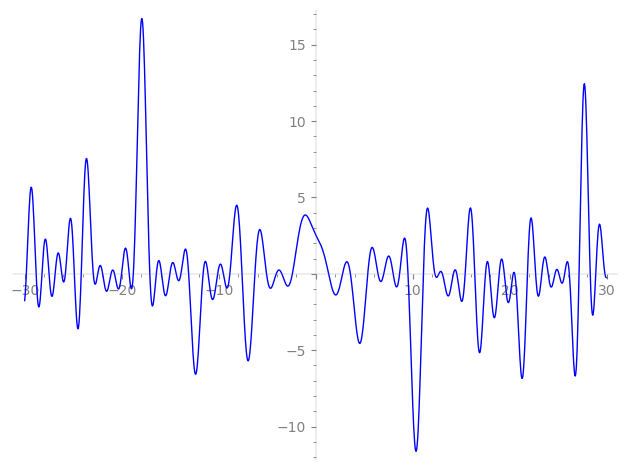| L(s) = 1 | + (0.866 − 0.5i)2-s + (1.68 + 2.91i)3-s + (0.499 − 0.866i)4-s + 0.659i·5-s + (2.91 + 1.68i)6-s + (−1.34 − 0.777i)7-s − 0.999i·8-s + (−4.16 + 7.21i)9-s + (0.329 + 0.570i)10-s + (1.85 − 1.07i)11-s + 3.36·12-s + (0.624 + 3.55i)13-s − 1.55·14-s + (−1.92 + 1.10i)15-s + (−0.5 − 0.866i)16-s + (1.15 − 2.00i)17-s + ⋯ |
| L(s) = 1 | + (0.612 − 0.353i)2-s + (0.971 + 1.68i)3-s + (0.249 − 0.433i)4-s + 0.294i·5-s + (1.19 + 0.687i)6-s + (−0.508 − 0.293i)7-s − 0.353i·8-s + (−1.38 + 2.40i)9-s + (0.104 + 0.180i)10-s + (0.559 − 0.323i)11-s + 0.971·12-s + (0.173 + 0.984i)13-s − 0.415·14-s + (−0.496 + 0.286i)15-s + (−0.125 − 0.216i)16-s + (0.280 − 0.486i)17-s + ⋯ |
\[\begin{aligned}\Lambda(s)=\mathstrut & 494 ^{s/2} \, \Gamma_{\C}(s) \, L(s)\cr =\mathstrut & (0.354 - 0.935i)\, \overline{\Lambda}(2-s) \end{aligned}\]
\[\begin{aligned}\Lambda(s)=\mathstrut & 494 ^{s/2} \, \Gamma_{\C}(s+1/2) \, L(s)\cr =\mathstrut & (0.354 - 0.935i)\, \overline{\Lambda}(1-s) \end{aligned}\]
Particular Values
| \(L(1)\) |
\(\approx\) |
\(2.10102 + 1.45045i\) |
| \(L(\frac12)\) |
\(\approx\) |
\(2.10102 + 1.45045i\) |
| \(L(\frac{3}{2})\) |
|
not available |
| \(L(1)\) |
|
not available |
\(L(s) = \displaystyle \prod_{p} F_p(p^{-s})^{-1} \)
| $p$ | $F_p(T)$ |
|---|
| bad | 2 | \( 1 + (-0.866 + 0.5i)T \) |
| 13 | \( 1 + (-0.624 - 3.55i)T \) |
| 19 | \( 1 + (-0.866 - 0.5i)T \) |
| good | 3 | \( 1 + (-1.68 - 2.91i)T + (-1.5 + 2.59i)T^{2} \) |
| 5 | \( 1 - 0.659iT - 5T^{2} \) |
| 7 | \( 1 + (1.34 + 0.777i)T + (3.5 + 6.06i)T^{2} \) |
| 11 | \( 1 + (-1.85 + 1.07i)T + (5.5 - 9.52i)T^{2} \) |
| 17 | \( 1 + (-1.15 + 2.00i)T + (-8.5 - 14.7i)T^{2} \) |
| 23 | \( 1 + (-0.453 - 0.785i)T + (-11.5 + 19.9i)T^{2} \) |
| 29 | \( 1 + (3.07 + 5.32i)T + (-14.5 + 25.1i)T^{2} \) |
| 31 | \( 1 + 6.56iT - 31T^{2} \) |
| 37 | \( 1 + (1.32 - 0.765i)T + (18.5 - 32.0i)T^{2} \) |
| 41 | \( 1 + (-5.06 + 2.92i)T + (20.5 - 35.5i)T^{2} \) |
| 43 | \( 1 + (-0.0986 + 0.170i)T + (-21.5 - 37.2i)T^{2} \) |
| 47 | \( 1 - 0.0646iT - 47T^{2} \) |
| 53 | \( 1 + 12.5T + 53T^{2} \) |
| 59 | \( 1 + (-12.4 - 7.19i)T + (29.5 + 51.0i)T^{2} \) |
| 61 | \( 1 + (-0.202 + 0.350i)T + (-30.5 - 52.8i)T^{2} \) |
| 67 | \( 1 + (-8.01 + 4.62i)T + (33.5 - 58.0i)T^{2} \) |
| 71 | \( 1 + (-4.35 - 2.51i)T + (35.5 + 61.4i)T^{2} \) |
| 73 | \( 1 + 6.09iT - 73T^{2} \) |
| 79 | \( 1 + 4.22T + 79T^{2} \) |
| 83 | \( 1 + 4.60iT - 83T^{2} \) |
| 89 | \( 1 + (-12.4 + 7.19i)T + (44.5 - 77.0i)T^{2} \) |
| 97 | \( 1 + (13.5 + 7.82i)T + (48.5 + 84.0i)T^{2} \) |
| show more | |
| show less | |
\(L(s) = \displaystyle\prod_p \ \prod_{j=1}^{2} (1 - \alpha_{j,p}\, p^{-s})^{-1}\)
Imaginary part of the first few zeros on the critical line
−11.09806798745016800645606473169, −10.11153130776650071033307718308, −9.518984315512043898381728465467, −8.849437544541948747971211743741, −7.59697917998467011479112121780, −6.27149240208633869068834597765, −5.07080525617881273657772626612, −4.06925735777245774260426430701, −3.49240887331674121933342515044, −2.40587378273361926860800852287,
1.32983422914842739076313408712, 2.76458848221660720606143596805, 3.57560386773521313824851516481, 5.36179949141067320751133612191, 6.42024715599464451384820855619, 7.01345855107815410094466292625, 7.983411618818655048936800647762, 8.645387064236115041734150652358, 9.511100802315528231593821681195, 11.08978193083863128624846231453

